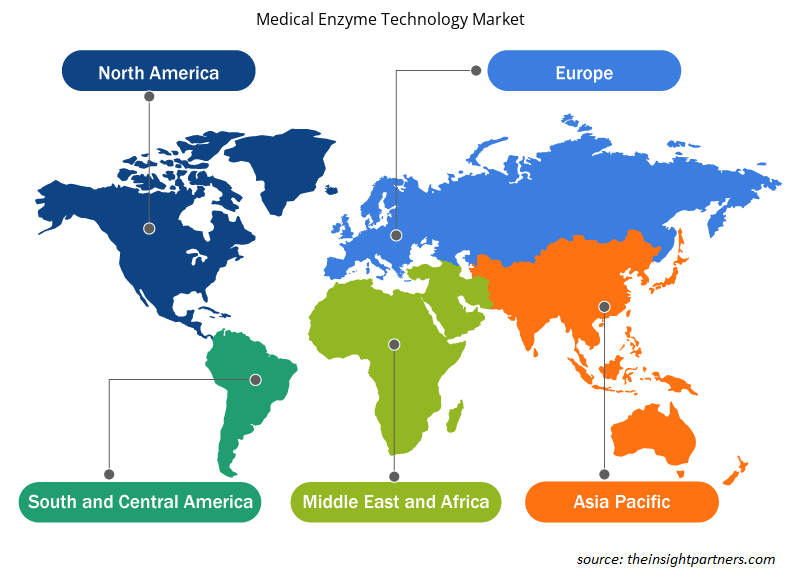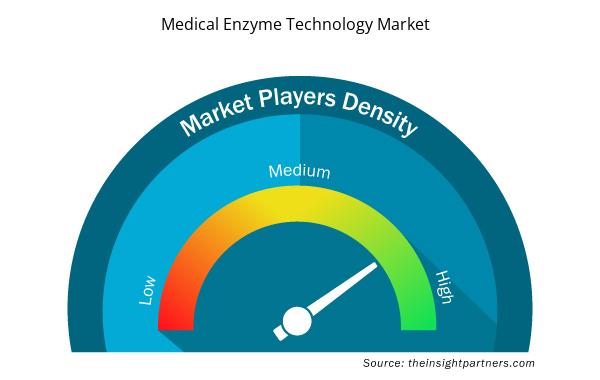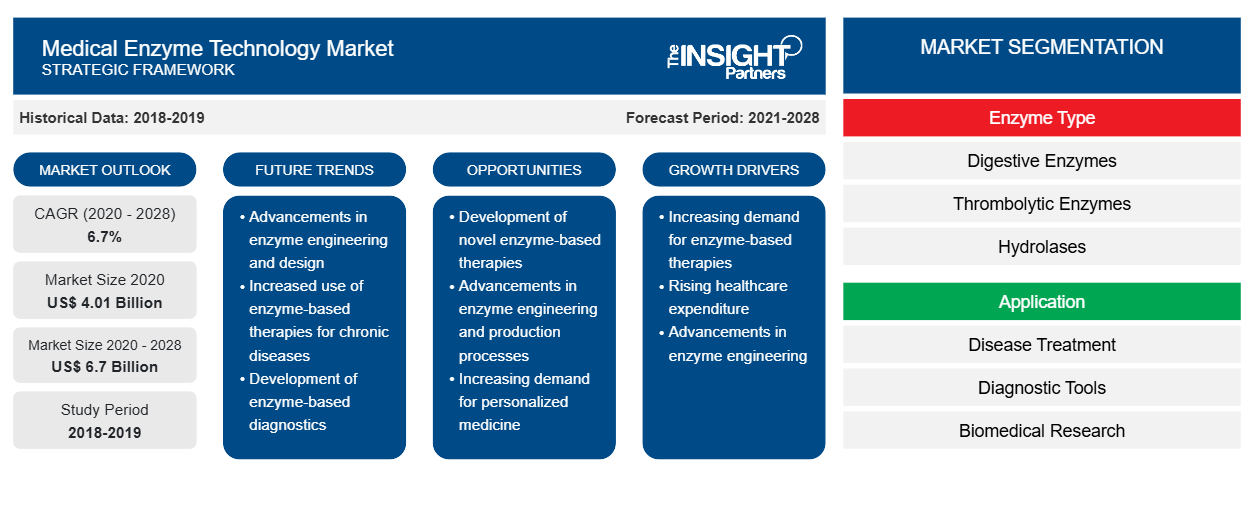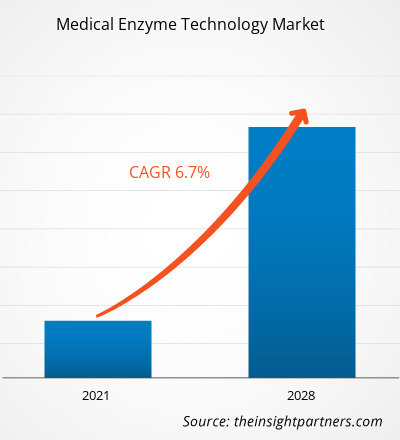Se espera que la tecnología de enzimas médicas alcance los US$ 6.700,00 millones para 2028 desde los US$ 4.012,57 millones en 2020; se estima que crecerá a una CAGR del 6,7% entre 2021 y 2028.CAGR of 6.7% from 2021 to 2028.
El mercado de tecnología de enzimas médicas se ha analizado en función del tipo de enzima, la aplicación y la región. El mercado según la región está segmentado en América del Norte, Europa, Asia Pacífico, Oriente Medio y África, y América del Sur y Central. El informe hace hincapié en parámetros como las tendencias del mercado, los avances tecnológicos, la dinámica del mercado y el análisis del panorama competitivo de las empresas líderes para ofrecer información y un análisis en profundidad del mercado de tecnología de enzimas médicas . También incluye el análisis de la pandemia de COVID-19 en todo el mercado en todas las regiones clave.
Perspectivas del mercado
Los avances en ingeniería enzimática se convertirán en una tendencia clave en el mercado de tecnología de enzimas médicas
La ingeniería enzimática desempeña un papel fundamental en el desarrollo de biocatalizadores eficientes para la biotecnología, las ciencias de la vida y la biomedicina. La ingeniería enzimática es el proceso de diseñar nuevos biocatalizadores con propiedades mejoradas mediante la alteración de sus secuencias de aminoácidos. A pesar de la inmensidad de posibles alteraciones, este procedimiento ya ha producido resultados notables en forma de diseños únicos y optimización de enzimas para la biosíntesis química y farmacéutica, la medicina regenerativa, la producción de alimentos, la biodegradación de residuos y la biodetección.biocatalysts for biotechnology, life sciences, and biomedicine. Enzyme engineering is the process of tailoring new biocatalysts with improved properties by altering their amino acid sequences. Despite the immensity of possible alterations, this procedure has already yielded remarkable results in the form of unique designs and optimization of enzymes for chemical and pharmaceutical biosynthesis, regenerative medicine, food production, waste biodegradation, and biosensing.
Personalice este informe según sus necesidades
Obtendrá personalización en cualquier informe, sin cargo, incluidas partes de este informe o análisis a nivel de país, paquete de datos de Excel, así como también grandes ofertas y descuentos para empresas emergentes y universidades.
- Obtenga las principales tendencias clave del mercado de este informe.Esta muestra GRATUITA incluirá análisis de datos, desde tendencias del mercado hasta estimaciones y pronósticos.
Además de los métodos clásicos de diseño racional y evolución dirigida, los métodos de aprendizaje automático (ML) se aplican cada vez más para encontrar patrones en los datos que ayuden a predecir las estructuras de las proteínas, mejorar la estabilidad, la solubilidad y la función de las enzimas, predecir la especificidad del sustrato y guiar el diseño racional de proteínas. El aprendizaje automático es un tercer enfoque para diseñar nuevos biocatalizadores, que ha ido ganando atención en las últimas décadas. A diferencia de los métodos de diseño racional basados en modelos, esta estrategia está basada en datos, ya que identifica patrones en los datos existentes para predecir las propiedades de una entrada desconocida pero similar. En enero de 2020, Curative Enzymes, un proveedor de productos y servicios, lanzó el servicio de ingeniería y modificación de enzimas para ayudar a los principales clientes.biocatalysts, which has been gaining attention since the past few decades. Unlike the model-driven rational designing methods, this strategy is data driven as it identifies patterns in the existing data to predict properties of an unknown but similar input. In January 2020, Curative Enzymes, a product and service provider, launched the enzyme engineering and modification service to help major clients.
Con la aparición de nuevas técnicas y métodos para reconstruir y diseñar enzimas, trabajar en ingeniería de proteínas se ha vuelto más conveniente, lo que ha permitido descubrir nuevos biocatalizadores y moléculas semisintéticos o sintéticos para aplicaciones industriales. Por lo tanto, es probable que los avances en ingeniería de enzimas sean una tendencia predominante en el mercado durante el período de pronóstico.semisynthetic or synthetic biocatalysts and molecules for industrial applications. Thus, advancements in enzyme engineering are likely to be a prevalent trend in the market during the forecast period.
Información basada en el tipo de enzima
El mercado de tecnología de enzimas médicas, por tipo de enzima, está segmentado en enzimas digestivas, enzimas trombolíticas, hidrolasas y endonucleasas. El segmento de hidrolasas tuvo la mayor participación del mercado en 2020; además, se prevé que el segmento de enzimas trombolíticas registre la CAGR más alta del mercado del 7,2 % durante el período de pronóstico.hydrolases, and endonucleases. The hydrolases segment held the largest share of the market in 2020; further, the thrombolytic enzymes segment is anticipated to register the highest CAGR of 7.2% in the market during the forecast period.
Perspectivas basadas en aplicaciones
El mercado de tecnología de enzimas médicas, por aplicación, está segmentado en tratamiento de enfermedades, herramientas de diagnóstico, investigación biomédica y otros. El segmento de tratamiento de enfermedades tuvo la mayor participación del mercado en 2020, y se prevé que el mismo segmento registre la CAGR más alta del mercado del 7,1 % durante el período de pronóstico.CAGR of 7.1% in the market during the forecast period.
Las empresas que operan en el mercado de tecnología de enzimas médicas están adoptando estrategias orgánicas como lanzamientos y expansiones de productos para expandir su presencia y cartera de productos en todo el mundo, así como para abordar las crecientes demandas.
Perspectivas regionales del mercado de tecnología de enzimas médicas
Los analistas de Insight Partners explicaron en detalle las tendencias y los factores regionales que influyen en el mercado de tecnología de enzimas médicas durante el período de pronóstico. Esta sección también analiza los segmentos y la geografía del mercado de tecnología de enzimas médicas en América del Norte, Europa, Asia Pacífico, Oriente Medio y África, y América del Sur y Central.

- Obtenga datos regionales específicos para el mercado de tecnología de enzimas médicas
Alcance del informe de mercado de tecnología de enzimas médicas
| Atributo del informe | Detalles |
|---|---|
| Tamaño del mercado en 2020 | US$ 4.01 mil millones |
| Tamaño del mercado en 2028 | 6.700 millones de dólares estadounidenses |
| Tasa de crecimiento anual compuesta (CAGR) global (2020-2028) | 6,7% |
| Datos históricos | 2018-2019 |
| Período de pronóstico | 2021-2028 |
| Segmentos cubiertos | Por tipo de enzima
|
| Regiones y países cubiertos | América del norte
|
| Líderes del mercado y perfiles de empresas clave |
|
Densidad de actores del mercado de tecnología de enzimas médicas: comprensión de su impacto en la dinámica empresarial
El mercado de tecnología de enzimas médicas está creciendo rápidamente, impulsado por la creciente demanda de los usuarios finales debido a factores como la evolución de las preferencias de los consumidores, los avances tecnológicos y una mayor conciencia de los beneficios del producto. A medida que aumenta la demanda, las empresas amplían sus ofertas, innovan para satisfacer las necesidades de los consumidores y aprovechan las tendencias emergentes, lo que impulsa aún más el crecimiento del mercado.
La densidad de actores del mercado se refiere a la distribución de las empresas o firmas que operan dentro de un mercado o industria en particular. Indica cuántos competidores (actores del mercado) están presentes en un espacio de mercado determinado en relación con su tamaño o valor total de mercado.
Las principales empresas que operan en el mercado de tecnología de enzimas médicas son:
- Merck
- Termo Fisher Scientific Inc.
- Novozimas
- Compañía farmacéutica Takeda Limited
- Tecnologías Agilent, Inc.
Descargo de responsabilidad : Las empresas enumeradas anteriormente no están clasificadas en ningún orden particular.

- Obtenga una descripción general de los principales actores clave del mercado de tecnología de enzimas médicas
Por tipo de enzima
- Enzima digestiva
- L-asparaginasa
- Lactasa
- Otros
- Enzima trombolítica
- Estreptoquinasa
- Uroquinasa
- Otros
- Enzima hidrolasa
- Hialuronidasa
- Lisozimas
- Otros
- Enzima endonucleasa
- Benzonasa
- Otros
Por aplicación
- Tratamientos de enfermedades
- Herramientas de diagnóstico
- Investigación biomédica
- Otros
Por
Geografía
América del norte
- A NOSOTROS
- Canadá
- México
Europa
- Francia
- Alemania
- Italia
- Reino Unido
- España
- Resto de Europa
Asia Pacífico (APAC)
- Porcelana
- India
- Corea del Sur
- Japón
- Australia
- Resto de APAC
Oriente Medio y África (MEA)
- Sudáfrica
- Arabia Saudita
- Emiratos Árabes Unidos
- Resto de MEA
América del Sur y Central (SCAM)
- Brasil
- Argentina
- Resto de estafa
Perfiles de empresas
- Merck
- Termo Fisher Scientific Inc.
- Novozimas
- Compañía farmacéutica Takeda Limited
- Tecnologías Agilent, Inc.
- Danaher (Cytiva)
- Sanofi
- Corporación Asahi Kasei
- Corporación Promega
- Enzima Amano Inc.
- Corporación Genzyme
- Análisis histórico (2 años), año base, pronóstico (7 años) con CAGR
- Análisis PEST y FODA
- Tamaño del mercado Valor/volumen: global, regional, nacional
- Industria y panorama competitivo
- Conjunto de datos de Excel



Report Coverage
Revenue forecast, Company Analysis, Industry landscape, Growth factors, and Trends

Segment Covered
This text is related
to segments covered.

Regional Scope
North America, Europe, Asia Pacific, Middle East & Africa, South & Central America

Country Scope
This text is related
to country scope.
Preguntas frecuentes
The costs of the Medical Enzyme Technology are much higher, and they may cost US$ 5–50, or more, per enzyme type. The cost may also differ from product to product types.
Key factors that are driving the market are advent of recombinant DNA technology, it has become possible to make formerly rare enzymes in large quantities and hence to reduce cost. Also, in pharmaceutical manufacturing, the desire to make chirally pure compounds is leading to new opportunities. Technological advances have facilitated the use of enzymes over an increasingly broad range of process conditions.
Enzymes are proteins produced in living cells of plants, animals, and microorganisms. All living organisms require enzymes for growth and for the production and utilization of energy which is essential for life. In the living cell, enzymes act as catalysts to speed up the chemical reactions which control life processes. Enzymes have been significant industrial products for more than a hundred years. However, the range of potential applications is increasing rapidly.
Trends and growth analysis reports related to Life Sciences : READ MORE..
The List of Companies - Medical Enzyme Technology Market
- Merck
- Thermo Fisher Scientific Inc.
- Novozymes
- TAKEDA PHARMACEUTICAL COMPANY LIMITED
- Agilent Technologies, Inc.
- Danaher (Cytiva)
- Sanofi
- Asahi Kasei Corporation
- Promega Corporation
- Amano Enzyme Inc
- Genzyme Corporation
The Insight Partners performs research in 4 major stages: Data Collection & Secondary Research, Primary Research, Data Analysis and Data Triangulation & Final Review.
- Data Collection and Secondary Research:
As a market research and consulting firm operating from a decade, we have published and advised several client across the globe. First step for any study will start with an assessment of currently available data and insights from existing reports. Further, historical and current market information is collected from Investor Presentations, Annual Reports, SEC Filings, etc., and other information related to company’s performance and market positioning are gathered from Paid Databases (Factiva, Hoovers, and Reuters) and various other publications available in public domain.
Several associations trade associates, technical forums, institutes, societies and organization are accessed to gain technical as well as market related insights through their publications such as research papers, blogs and press releases related to the studies are referred to get cues about the market. Further, white papers, journals, magazines, and other news articles published in last 3 years are scrutinized and analyzed to understand the current market trends.
- Primary Research:
The primarily interview analysis comprise of data obtained from industry participants interview and answers to survey questions gathered by in-house primary team.
For primary research, interviews are conducted with industry experts/CEOs/Marketing Managers/VPs/Subject Matter Experts from both demand and supply side to get a 360-degree view of the market. The primary team conducts several interviews based on the complexity of the markets to understand the various market trends and dynamics which makes research more credible and precise.
A typical research interview fulfils the following functions:
- Provides first-hand information on the market size, market trends, growth trends, competitive landscape, and outlook
- Validates and strengthens in-house secondary research findings
- Develops the analysis team’s expertise and market understanding
Primary research involves email interactions and telephone interviews for each market, category, segment, and sub-segment across geographies. The participants who typically take part in such a process include, but are not limited to:
- Industry participants: VPs, business development managers, market intelligence managers and national sales managers
- Outside experts: Valuation experts, research analysts and key opinion leaders specializing in the electronics and semiconductor industry.
Below is the breakup of our primary respondents by company, designation, and region:

Once we receive the confirmation from primary research sources or primary respondents, we finalize the base year market estimation and forecast the data as per the macroeconomic and microeconomic factors assessed during data collection.
- Data Analysis:
Once data is validated through both secondary as well as primary respondents, we finalize the market estimations by hypothesis formulation and factor analysis at regional and country level.
- Macro-Economic Factor Analysis:
We analyse macroeconomic indicators such the gross domestic product (GDP), increase in the demand for goods and services across industries, technological advancement, regional economic growth, governmental policies, the influence of COVID-19, PEST analysis, and other aspects. This analysis aids in setting benchmarks for various nations/regions and approximating market splits. Additionally, the general trend of the aforementioned components aid in determining the market's development possibilities.
- Country Level Data:
Various factors that are especially aligned to the country are taken into account to determine the market size for a certain area and country, including the presence of vendors, such as headquarters and offices, the country's GDP, demand patterns, and industry growth. To comprehend the market dynamics for the nation, a number of growth variables, inhibitors, application areas, and current market trends are researched. The aforementioned elements aid in determining the country's overall market's growth potential.
- Company Profile:
The “Table of Contents” is formulated by listing and analyzing more than 25 - 30 companies operating in the market ecosystem across geographies. However, we profile only 10 companies as a standard practice in our syndicate reports. These 10 companies comprise leading, emerging, and regional players. Nonetheless, our analysis is not restricted to the 10 listed companies, we also analyze other companies present in the market to develop a holistic view and understand the prevailing trends. The “Company Profiles” section in the report covers key facts, business description, products & services, financial information, SWOT analysis, and key developments. The financial information presented is extracted from the annual reports and official documents of the publicly listed companies. Upon collecting the information for the sections of respective companies, we verify them via various primary sources and then compile the data in respective company profiles. The company level information helps us in deriving the base number as well as in forecasting the market size.
- Developing Base Number:
Aggregation of sales statistics (2020-2022) and macro-economic factor, and other secondary and primary research insights are utilized to arrive at base number and related market shares for 2022. The data gaps are identified in this step and relevant market data is analyzed, collected from paid primary interviews or databases. On finalizing the base year market size, forecasts are developed on the basis of macro-economic, industry and market growth factors and company level analysis.
- Data Triangulation and Final Review:
The market findings and base year market size calculations are validated from supply as well as demand side. Demand side validations are based on macro-economic factor analysis and benchmarks for respective regions and countries. In case of supply side validations, revenues of major companies are estimated (in case not available) based on industry benchmark, approximate number of employees, product portfolio, and primary interviews revenues are gathered. Further revenue from target product/service segment is assessed to avoid overshooting of market statistics. In case of heavy deviations between supply and demand side values, all thes steps are repeated to achieve synchronization.
We follow an iterative model, wherein we share our research findings with Subject Matter Experts (SME’s) and Key Opinion Leaders (KOLs) until consensus view of the market is not formulated – this model negates any drastic deviation in the opinions of experts. Only validated and universally acceptable research findings are quoted in our reports.
We have important check points that we use to validate our research findings – which we call – data triangulation, where we validate the information, we generate from secondary sources with primary interviews and then we re-validate with our internal data bases and Subject matter experts. This comprehensive model enables us to deliver high quality, reliable data in shortest possible time.


 Obtenga una muestra gratuita de este informe
Obtenga una muestra gratuita de este informe